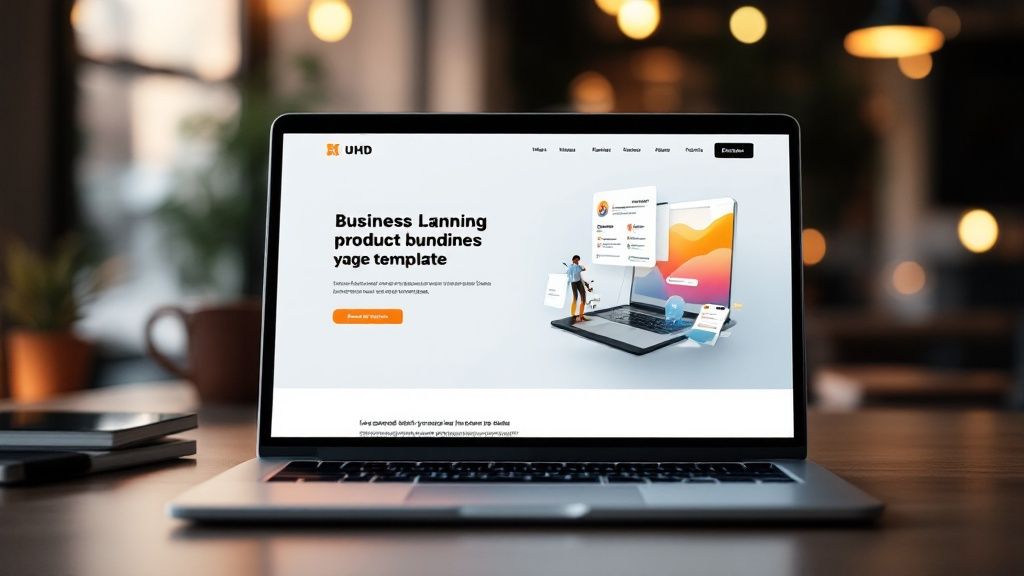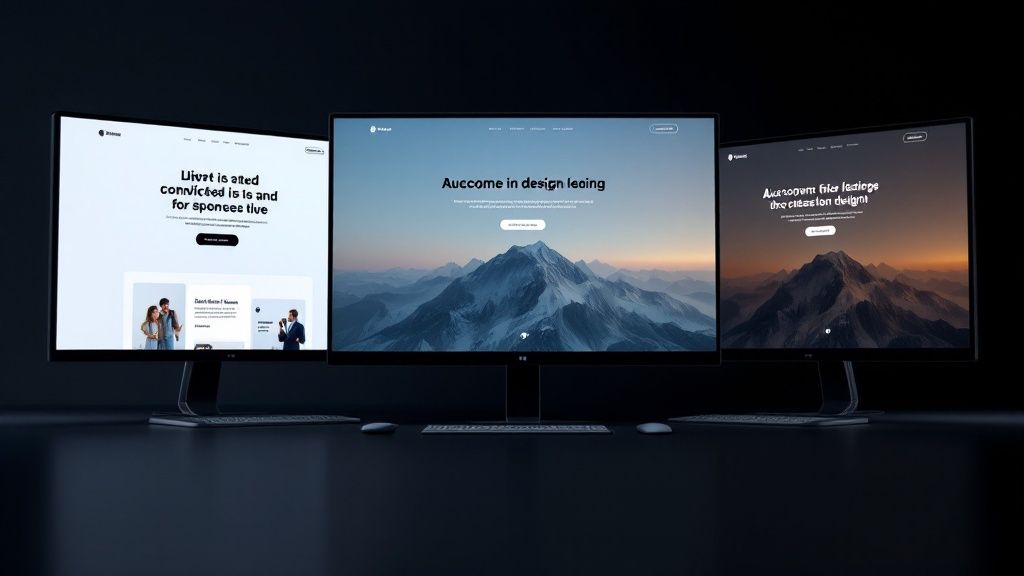Boost Conversions with Optimized Product Landing Page Templates
November 22, 2024

Introduction to Product Landing Page Templates

In the competitive world of online commerce, grabbing a customer's attention and guiding them towards a purchase is paramount. This is where product landing page templates become essential tools. A product landing page template provides a blueprint for creating focused web pages designed specifically for converting visitors into buyers. Think of it as a pre-designed house: the basic structure is already there, allowing you to quickly customize and furnish it to your specific needs instead of building from the ground up. This allows businesses to launch targeted marketing campaigns efficiently and optimize their sales funnels. This exploration delves into the world of product landing page templates, highlighting their importance in driving conversions and maximizing the effectiveness of your online presence.
Why Use Product Landing Page Templates?
The main advantage of using product landing page templates lies in their ability to simplify the creation process. Imagine having to build a new webpage for every product launch or marketing campaign—the time and resources required would be considerable. Product landing page templates, however, offer a pre-designed framework, complete with key elements such as headlines, call-to-action buttons, and image placeholders. This means that, rather than starting with a blank page, you can focus on tailoring the content and visuals to your specific product and target audience. This efficiency is particularly beneficial for businesses with limited development resources. This streamlined process frees up time and resources, allowing businesses to focus on other critical aspects of their operations.
Benefits of Product Landing Page Templates
Beyond efficiency, product landing page templates provide a host of other benefits. For instance, many templates are designed with conversion optimization best practices in mind. This might include strategically placed CTAs, clear and concise messaging, and persuasive design elements. Using a template also ensures a consistent brand experience across different landing pages, strengthening your brand identity and fostering trust with visitors. Furthermore, most product landing page templates are mobile-responsive, seamlessly adapting to various screen sizes. This is critical in our current environment, where a substantial portion of online traffic originates from mobile devices. These advantages collectively contribute to a more effective and user-friendly online experience.
Choosing the Right Product Landing Page Template
Selecting the right template hinges on your particular product and marketing goals. Some templates are designed for showcasing a single product, while others are better suited for promoting multiple products or services. Consider the type of content you need to include, such as videos, testimonials, or detailed product specifications. A template like those offered by services like Checkout Links can prove especially useful for Shopify merchants. Checkout Links allows for the creation of shoppable links leading to pre-filled carts, automatically applied discounts, and personalized landing pages, significantly improving the customer journey and driving sales. Ultimately, the best product landing page template aligns with your brand, resonates with your target audience, and effectively guides visitors towards the desired outcome. Choosing wisely can mean the difference between a successful campaign and a missed opportunity.
Essential Elements of Effective Landing Pages
Building upon the foundation of product landing page templates, let's explore the crucial elements that make these pages truly effective. Just as a structurally sound building requires a strong foundation, impactful landing pages need carefully crafted components working together. This section examines those critical building blocks.
Compelling Headline and Value Proposition
First impressions are everything. A compelling headline acts as the gateway to your product, capturing the visitor’s attention and sparking their interest. It should be concise, benefit-oriented, and clearly communicate the value your product offers. For instance, instead of simply saying "New Software," a stronger headline would be "Boost Your Productivity with Our Intuitive New Software." This clearly conveys the benefit to the potential customer. Following this, a concise and persuasive value proposition should further detail the advantages, addressing the visitor’s potential needs and pain points. This combination creates a powerful opening that entices visitors to learn more.
Engaging Visuals and Multimedia
Visuals are powerful tools. High-quality images or videos demonstrating your product in use can significantly increase engagement. Imagine seeing a picture of a delicious meal versus just reading a description—the visual is far more appealing. Similarly, showcasing your product through compelling visuals strengthens the connection with visitors. Product landing page templates often include designated areas for these elements, ensuring a visually appealing design. This visual appeal can greatly influence a visitor's perception of your product.
Clear Call to Action (CTA)
A clear and compelling call to action is the core of any effective landing page. This is the button or link that directs visitors towards the desired action, whether it’s making a purchase, signing up for a trial, or downloading a resource. A well-designed CTA should be visually prominent, using contrasting colors and action-oriented wording. For example, instead of a generic "Click Here" button, opt for phrases like "Get Started Now" or "Download Your Free Guide." The CTA's strategic placement on the page maximizes visibility and encourages conversions. Its effectiveness directly impacts the success of your landing page.
Social Proof and Trust Signals
Trust is fundamental for turning visitors into customers. Incorporating social proof, like testimonials, customer reviews, or social media endorsements, can build credibility. Think about seeking recommendations from friends before trying a new restaurant—positive reviews instill confidence. Likewise, showcasing positive feedback from other customers can reassure potential buyers. Product landing page templates often have sections for displaying testimonials and other trust signals, simplifying the process of building credibility. Furthermore, consider including security badges or guarantees to provide additional reassurance. These elements collectively build a strong foundation of trust.
Concise and Scannable Content
While visuals are important, clear and concise copy is equally critical. Visitors often scan web pages quickly, so your content must be easily digestible. Use headings, subheadings, bullet points, and short paragraphs to break up large blocks of text and enhance readability. This allows visitors to quickly grasp the key features and benefits of your product without feeling overwhelmed. Focus on highlighting the most relevant information and avoid technical jargon that could confuse your audience. You might be interested in: How to master Shopify sales with landing pages. This ensures even those short on time can understand your product's value. This structured approach strengthens your landing page's communication and drives conversions, which product landing page templates are designed to facilitate.
Popular Template Styles and Trends

Creating effective landing pages involves not only utilizing essential elements but also understanding prevailing trends and template styles. Staying current with the latest design principles is key to creating product landing page templates that resonate with today's audiences. Just as fashion evolves, so do the preferred aesthetics and functionality of effective online experiences. This section explores popular product landing page template styles and current trends.
Minimalist Design
Minimalist design remains a popular trend in product landing page templates. This style emphasizes clean lines, ample white space, and a focused presentation of essential information. Think of it as a carefully curated art gallery: a few select pieces make a greater impact than a cluttered room. This approach minimizes distractions and helps visitors quickly understand the value proposition and take action. A product landing page template with a single, high-quality product image, a concise headline, and a prominent call-to-action button exemplifies this aesthetic. This simplicity can be highly effective.
Interactive Storytelling
Interactive storytelling is a growing trend that adds a new dimension of engagement to product landing page templates. Instead of passively absorbing information, visitors actively participate in the narrative. Imagine choosing your own adventure in a book—interactive elements like quizzes or personalized product configurators similarly allow users to shape their experience, making it more memorable and persuasive. This approach is particularly effective for complex products or services that require user education. This active participation can lead to greater understanding and interest.
Video-Centric Templates
Video's increasing importance in online communication is reflected in the rising popularity of video-centric product landing page templates. Videos can convey substantial information concisely and engagingly, meaning visitors can watch a short video demonstrating the product's features instead of reading lengthy descriptions. Templates designed to showcase video content prominently, often featuring large hero videos or embedded video testimonials, are gaining traction. This allows businesses to connect with their audience more emotionally, strengthening engagement and driving conversions. Services like Checkout Links offer templates optimized for product videos, helping Shopify merchants leverage this format to boost sales. Video's dynamic nature can be a significant asset.
Full-Screen Experiences
Full-screen product landing page templates immerse visitors in a visually captivating experience. These templates frequently use large background images or videos that fill the entire screen, creating a sense of drama and immediacy. Think of entering a movie theater—the expansive screen draws you into the story. This approach can be particularly effective for visually-driven products or brands wanting to make a bold statement. However, it’s crucial to balance visual appeal with functionality, ensuring key information and calls to action are easily accessible. Achieving this balance allows full-screen experiences to effectively capture attention and drive conversions. This balance is essential for maximizing impact.
Customization and Optimization Tips

Choosing the right product landing page template is a crucial first step, but the real work lies in customization and optimization. This is where you transform a generic template into a high-converting engine specifically tailored to your product and audience. Consider a product landing page template like an off-the-rack suit – it has potential but requires tailoring to fit perfectly. This section explores key customization and optimization tips.
Personalizing Your Template
Effective customization involves more than simply changing images and text. It requires understanding your target audience and tailoring the experience to their needs and preferences. For example, when targeting a younger demographic, you might use a more vibrant color scheme and informal language, while a B2B audience might respond better to a more professional and data-driven approach. Consider every element, from the headline to the call to action, to ensure it aligns with your brand and speaks directly to your ideal customer. This targeted approach maximizes the impact of your message.
A/B Testing for Optimal Performance
A/B testing is a vital optimization technique that allows you to compare different versions of your landing page and determine which performs best. This involves creating two slightly different versions, perhaps with variations in headlines, images, or call-to-action placement, then directing traffic to both and tracking metrics like conversion rates and click-through rates. This data-driven approach helps refine your template over time, ensuring continuous improvement and optimal results. Think of it like trying different fishing lures to see which attracts the most fish—A/B testing does the same for your landing page. This iterative process leads to data-backed improvements.
Content Optimization for Conversions
Your landing page content should be concise, persuasive, and benefit-focused. Visitors rarely read every word, so structure your content for easy scanning. Use headings, bullet points, and short paragraphs to break up large text blocks and highlight key information. Also, optimize your content for search engines by incorporating relevant keywords. However, avoid keyword stuffing, which can negatively impact search rankings. Think of your content as a sales pitch—it needs to be clear, concise, and compelling to encourage conversions. Services like Checkout Links provide templates designed with these content optimization principles, helping Shopify merchants create effective and engaging landing pages. This streamlined approach focuses visitor attention and guides them toward conversion.
Integrating with Your Marketing Ecosystem
Your product landing page shouldn’t exist in a vacuum. It should integrate seamlessly with your broader marketing ecosystem, connecting to your email marketing platform, CRM system, and analytics tools. This allows you to track performance, gather valuable visitor data, and personalize their experience. For example, you can use CRM data to customize landing page content for specific customer segments. This integrated approach ensures your landing page works harmoniously with other marketing efforts, maximizing your overall ROI and providing a consistent brand experience. This holistic approach leverages the full power of your marketing tools.
Mobile Responsiveness

Continuing the discussion on customization and optimization, we reach a critical aspect of modern web design: mobile responsiveness. This is the ability of a website, or in this case a product landing page, to adapt its layout and content to different screen sizes. This adaptability is essential because people access websites on a range of devices. If a product landing page isn't mobile-responsive, it creates a frustrating user experience, making it difficult for visitors to navigate, read, or click buttons. This can lead to lost conversions and damage your brand. Ensuring mobile responsiveness is paramount when selecting and customizing templates.
Why Mobile Responsiveness Matters for Product Landing Page Templates
Mobile responsiveness is especially important for product landing page templates because these pages are often the first point of contact a potential customer has with your product, making a positive first impression vital. Imagine trying to read a newspaper printed on a sheet much larger than your desk; it would be difficult to navigate and understand. Similarly, a non-responsive landing page on a mobile device hinders visitor engagement and comprehension of your product's value. This can increase bounce rates and decrease conversions, impacting your overall marketing effectiveness. Prioritizing mobile responsiveness is essential for making a positive first impression.
How Responsive Design Improves User Experience
Responsive design automatically adjusts a landing page's layout, font sizes, and images to fit the screen size of the device being used. This provides a consistent user-friendly experience, regardless of whether someone is browsing on a desktop, tablet, or smartphone. For instance, a responsive design might condense a multi-column layout into a single column on smaller screens for easier reading and navigation. It also ensures that call-to-action buttons are appropriately sized and easily clickable on touchscreens. Prioritizing this seamless experience across all devices significantly improves engagement and encourages conversions, creating a more effective online presence. You might be interested in: How to master landing pages for e-commerce design optimization. This ultimately contributes to a more successful online strategy.
Finding and Using Mobile-Responsive Product Landing Page Templates
Fortunately, many product landing page templates are designed with mobile responsiveness in mind. Look for templates explicitly labeled as "mobile-friendly" or "responsive." When customizing your chosen template, preview and test it on various devices to ensure it displays and functions correctly across all screen sizes. This attention to mobile responsiveness is key to creating product landing pages that convert visitors into customers, regardless of their device. This attention to detail ensures a positive user experience across the board.
Conclusion and Best Practices
This exploration of product landing page templates has emphasized their critical role in converting visitors into customers. From understanding the core components of effective landing pages to choosing the right template and optimizing it for conversions, we've examined the key aspects of creating high-performing pages. By applying these principles, businesses can significantly improve their online marketing efforts and drive sales. This final section summarizes the main takeaways and offers practical best practices.
Key Takeaways
- Templates as a Foundation: Product landing page templates offer a valuable starting point, saving time and resources while incorporating conversion-focused design principles. Think of it like using a recipe—it provides a framework, but you can still adapt it.
- Essential Elements: A compelling headline, engaging visuals, a clear call to action, social proof, and concise content are the fundamental components of an effective landing page. These elements work in concert to create a resonant message.
- Customization is Key: Personalizing your template to your brand, product, and target audience is crucial for maximizing conversions. It's about making the template truly your own.
- Mobile Responsiveness is Crucial: Ensuring your landing page is accessible and user-friendly on all devices is essential in today's environment.
- Continuous Optimization: A/B testing and ongoing optimization are essential for refining your landing page and maximizing its performance. It's a process of continual improvement.
Best Practices for Utilizing Product Landing Page Templates
- Define Your Goals: Begin with a clear understanding of your objectives. What do you want visitors to do? This clarity guides your template selection and customization.
- Know Your Audience: Tailor your messaging and visuals to your target audience. Speak their language and address their needs.
- Test and Iterate: Don’t just set it and forget it. Continuously test different elements to determine what resonates most effectively.
Ready to improve your Shopify store's conversion rates? Checkout Links provides effective product landing page templates designed to streamline your sales and boost your bottom line. Visit Checkout Links today and start creating high-converting landing pages that turn visitors into loyal customers.
 Checkout Links
Checkout Links



